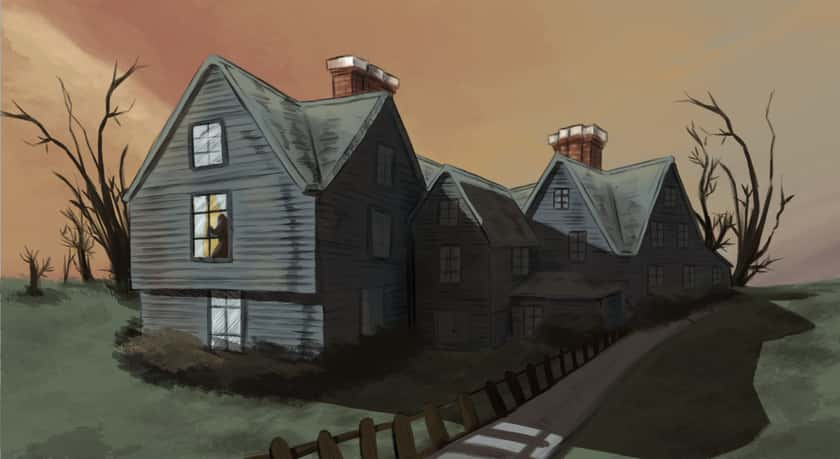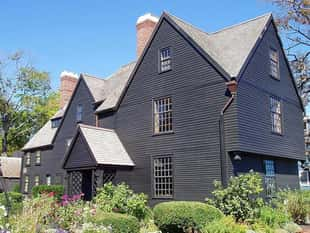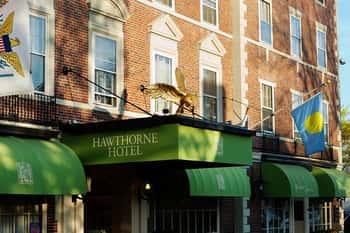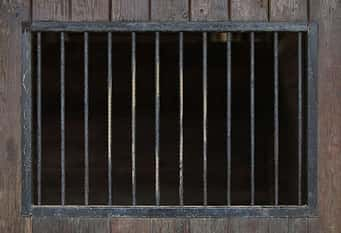They say that there is no house in Salem more haunted than the Turner-Ingersoll, better known to many as the House of the Seven Gables. With its Gothic-inspired cross-gables and dark-as-coffee wood clapboards, Turner and Ingersoll’s infamous House of the Seven Gables looks like something out of a Hansel and Gretel spin-off.
And we all know what happened to them--the breadcrumbs worked only for so long.
But while Hansel and Gretel faced their own fate, the Turner-Ingersoll has been given a variety of fates over the years; a variety of identities, too, depending on the century and on the owner.
Once the home of a hat and shoe merchant, this historic property on Salem’s Derby Street now belongs to the House of the Seven Gables Settlement Association along with several other centuries-old homes. Today, it functions as a museum and event location, welcoming all through its doors to learn about the Salem-born author, Nathaniel Hawthorne, and life during the 1840s.
As for the ghosts of the Turner-Ingersoll, it depends upon who you ask as to whether or not they exist. Will you believe in the haunted House of the Seven Gables?
Before there was Hepzibah Pyncheon from Nathaniel Hawthorne’s 1851 novel, The House of the Seven Gables, there was John Turner, a son of an indentured servant from England.
Despite his father’s arrival to the American Colonies under a system that ensured at least seven to twelve years of servitude to his employer (read: his master), John Turner quickly stamped his mark on Salem, Massachusetts. He was an invested hat and shoe merchant, and by 1668, had amassed a large enough fortune to construct a new house.
That house was the much-later nicknamed House of the Seven Gables.
The original structure was simple in nature, with only two rooms and two-and-a-half stories tall. But Turner was not content with just being a hat merchant--no, there was much more money to be made. He worked in Salem’s maritime field, becoming a Captain and accumulating more money than his neighbors would ever know what to do with.
By the time of Turner’s death in 1742, he was one of the most wealthy men in the entirety of the Massachusetts Bay Colony. His probate inventory (i.e., an itemized list of his ownings at the time of his death) spanned fourteen pages when the average inventory for the period was perhaps just one or two sheets long.

In fact, John Turner’s son (John Turner II) inherited six homes in the bay area, 200 acres of land and a handful of ships docked at Salem’s port.
A former researcher for the Colonial Williamsburg Foundation, Cary Carson, once wrote, “Today it is the lone survivor in New England of the kind of high-gentry house that introduced to North America new cosmopolitan ideas about domestic living in the last quarter of the 17th century. Merchant John Turner built himself a bigger, better dwelling than most of his neighbors owned.”
Indeed, John Turner did exactly that. Unfortunately, the third generations of Turners in Salem lost the fell swoop of the fortune and the prized family home was sold in 1782 to Samuel Ingersoll.
When sea captain Samuel Ingersoll took on the Turner House, it had grown exponentially from its original two-room dwelling. John Turner I had later added a kitchen leanto, a south wing to the house, and a two-story porch.
He also added the “secret staircase” known to many, thanks to Nathaniel Hawthorne’s House of the Seven Gables.
But Samuel Ingersoll intended to fancy up the place even more. He removed the famed gables and exchanged them for intricate Victorian detail-work. The Turner House became the Turner-Ingersoll Mansion.
It was during the Ingersoll-era that Samuel’s daughter, Susannah (some records call her Susan), frequently invited her cousin, Nathaniel Hawthorne.
Author Rosemary Ellen Guiley of Haunted Salem once wrote that Turner and Ingersoll’s House of the Seven Gables is a “ghostly reminder of shipping fortunes made and then lost, a bust blamed on the curse of the witch trials of 1692.”
But the Turner-Ingersoll is a reminder for more than just lost shipping fortunes--it is also a blatant reminder of Nathaniel Hawthorne’s guilt.
It was Hawthorne’s great-grandfather, John Hathorne, who served as a judge during the Salem witch trials of 1692. As records show, Hathorne may have feigned sympathy for the accused witches, but he never regretted his involvement in their trials and executions. And he certainly never expressed any remorse during the trials themselves for sending the accused to their deaths.
It’s said that Hathorne truly believed in the evil of witchcraft and thought it to be a real threat to the population of Salem.
Following the witch hysteria of the late 1600s, the Hathorne family lost most of their wealth. Even their high status within society plummeted, no doubt influenced by the families of the accused witches who sought justice for their dead loved ones.
By the time Nathaniel was born in 1804, the so-called curse of the Hathorne family had not yet been lifted.
During the days that he spent with his cousin Susannah in the 1840s, she revealed more and more of their family’s turbulent past. She regaled him with stories of his family’s involvement with slavery and other evils. At first, Nathaniel confessed to an interest in the Salem witch trials. But with age and maturity came a sort of revulsion for his ancestor Judge John Hathorne--to the point that he allowed Susannah to convince him to alter his last name.
Until some generations before John Hathorne, the Hathorne name had actually been spelled as Hawthorne, with a “w.”
Speaking to Nathaniel’s concern over his budding author career, Susannah persuaded Nathaniel to add the “w” back in. That way, she said, no one would ever know of Nathaniel’s dark, shameful lineage.
Unfortunately, despite the surname switch, Nathaniel’s complete disgust over John Hathorne’s sins made a frequent experience in a lot of his literary work.
Nathaniel Hawthorne and the House of the Seven Gables
In the opening pages of Nathaniel Hawthorne’s debut novel, The Scarlet Letter, he took the time to apologize for his family’s involvement in the Salem witch trials.
He wrote:
“He [Judge Hathorne] made himself so conspicuous in the martyrdom of the witches, that their blood may fairly be said to have left a stain upon him . . . I know not whether these ancestors of mine bethought themselves to repent, and ask pardon of heaven for their cruelties . . . At all events, I, the present writer, as their representative, hereby take shame upon myself for their sakes, and pray that any curse incurred by them . . . may be now and henceforth removed.”
The book that made the Turner-Ingersoll was no better in showing Nathaniel Hawthorne’s desire to separate his identity from that of his ancestors’.
The following year in 1851, with the release of the critically acclaimed House of the Seven Gables, Hawthorne was at it again. The book’s plot was centrally based on Hawthorne’s own family and Judge John Hathorne’s fight with Philip English, whose wife Hathorne had condemned to death for witchcraft.
In the book, the Pyncheon family has allegedly suffered greatly for its involvement with the witch hysteria. But as Judge Pyncheon desperately wants his next-door neighbor’s land, he sets a course of action to see that neighbor, Thomas Maule, is convicted for witchcraft.
Poor Thomas Maule is at the gallows on Gallows Hill when he curses the Pyncheon family: “God will give you blood to drink and quench your greed for eternity.”
Judge Pyncheon ignores the threat and continues on with life. He takes the Maule land and builds an illustrious estate on it, including a house that is said to have looked eerily like the Turner-Ingersoll Mansion (aka the House of the Seven Gables).
But, Pyncheon’s good fortune quickly seeps away. At the first dinner in the house, the judge dies. And he does so by choking on his own blood. (Game of Thrones’ red wedding, anyone? Now we know where George R.R. Martin got his inspiration.)
Following Pyncheon’s ill-timed death, the land is once again restored to the Maule family and all live happily ever after.
Or, happily ever after for now at least.
Much like the Turner family, the Ingersolls lost their mansion after three generations (maybe that is the real curse), when Susannah’s son Horace lost the family fortune and sold the house in 1879.
According to one New York Times article, “by 1870 a Salem guidebook had already identified the building as ‘The House of the Seven Gables.’”
In 1908, philanthropist Caroline Emmerton purchased the infamous Turner-Ingersoll Mansion with the intention of converting it into a museum. She hired the noted restoration architect, Joseph Everett Chandler, to handle all renovation projects. Interestingly, Chandler had just come off a project of restoring the Paul Revere House in Boston.
Under Caroline Emmerton’s instruction, Chandler brought back to life the eight (not seven!) gables of the home, as well as to re-create Hepzibah Pyncheon’s Cent Shop featured in the book.
Today, Turner and Ingersoll’s House of the Seven Gables is much more than a single museum. Emmerton purchased and moved other properties related to Nathaniel Hawthorne to the Turner Street location.
When you visit the Turner-Ingersoll you are truly stepping back in time--and, if you’re lucky, you might even have a chance to take a peek at the secret staircase.
Is the Turner-Ingersoll haunted?
Well, it sort of depends upon who you ask.
Each year, the museum hosts a series of theatrical plays, all of which surround the Salem Witch Trials. Such plays as, Legacy of the Hanging Judge (i.e. Judge John Hathorne) and Spirits of the Gables, which is a recreation of Nathaniel Hawthorne’s book.
As for the ghosts outside of the theatrical performances . . . well, everyone has got their opinion on that. Tour guides and employees tend to argue that the Turner-Ingersoll is not haunted at all. When asked if there are any spirits lurking around the house, they are quick to reply, “Nope! No ghosts here.”
But local lore has a different story to tell, and so do many of the visitors who enter Salem’s “House of the Seven Gables.”
For many years there have been a number of spirits reported at the Turner-Ingersoll Mansion.
In the famous, secret staircase, visitors have witnessed the spirit of a man clambering up and down the stairs. Those who have seen him are quick to link his spectral existence to the Underground Railroad. But, the Turner House (even during the 18th and 19th centuries) was never a stop on the Underground Railroad, and those secret steps were not even built until nearly fifty years after the closing of the Civil War.
Others report seeing a phantom boy who enjoys playing in the attic. Throughout the day, his little footsteps can be heard pouncing around upstairs as he giggles and laughs. According to one historian, the attic space once functioned as the servants’ quarters for the property--is it possible, then, that the ghostly boy is none other than one of the servants who once lived here?
Maybe, if you believe that version of the haunting tale. For others, they adamantly believe that the little boy is Julian, the son of Nathaniel Hawthorne. Personally, I find this hard to believe, since, by the time Hawthorne did have children, he no doubt wouldn’t have been visiting the Turner-Ingersoll Mansion as frequently as he’d done in his youth.
The last frequently seen spectre at the House of the Seven Gables is none other than Susannah Ingersoll, Nathaniel Hawthorne’s cousin who regaled him with the terrible tales of the Salem witch hysteria. Her spirit has been spotted walking the halls of her former home and even peeking out the windows to those who enter the estate through the garden below.
Has the ghost of Susan Ingersoll never left, then? It seems likely, according to the various reports, that she is perfectly content to remain at the home that her father bought from the impoverished John Turner III.
Should you be feeling the desire to walk the same path of the author, Nathaniel Hawthorne, there is no better place to do it than at the Turner-Ingersoll – Hawthorne’s “House of the Seven Gables.”
The museum comprises his former birthplace, his childhood home, and, yes, the House of the Seven Gables as well. As for the ghosts and hauntings, your best luck will be in the attic space of the Turner-Ingersoll, where one witness claimed to have been choked by invisible hands.
Whether the house is haunted depends on who you ask and your personal beliefs. But don’t say we didn’t warn you when the unbelievable occurs.

One of Salem's most famous haunted houses

Spend a night in Salem's most haunted hotel

One of Salem's most haunted places